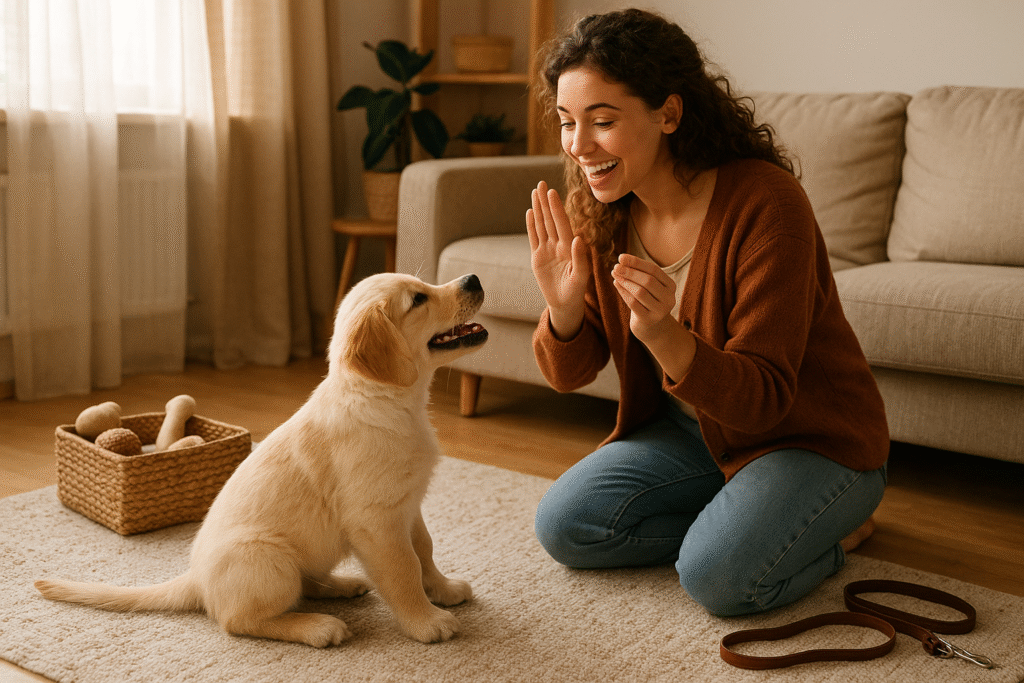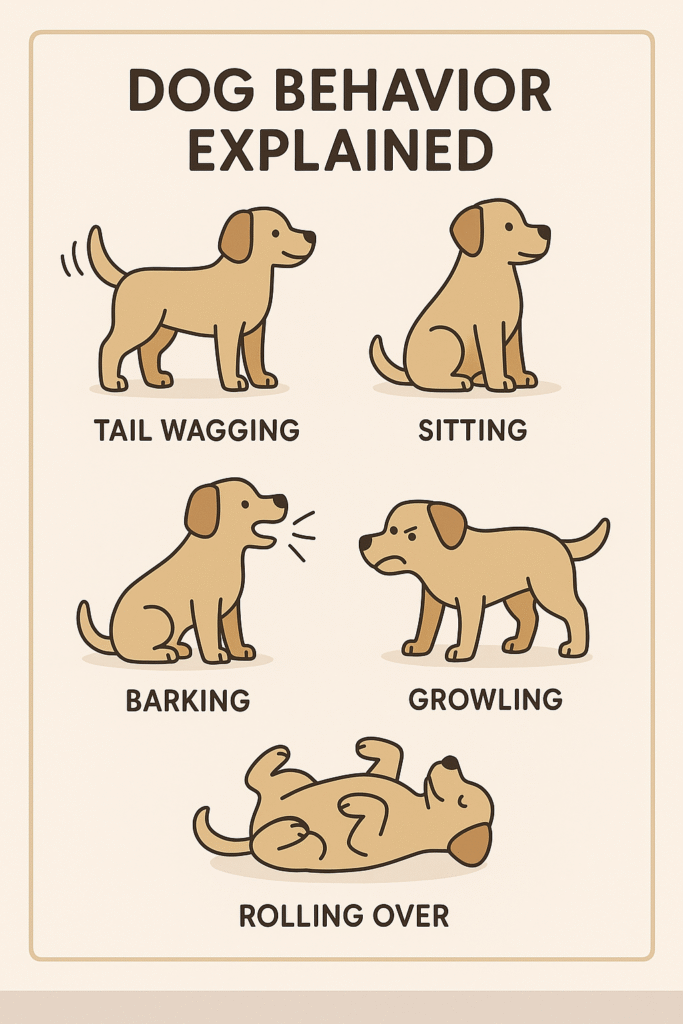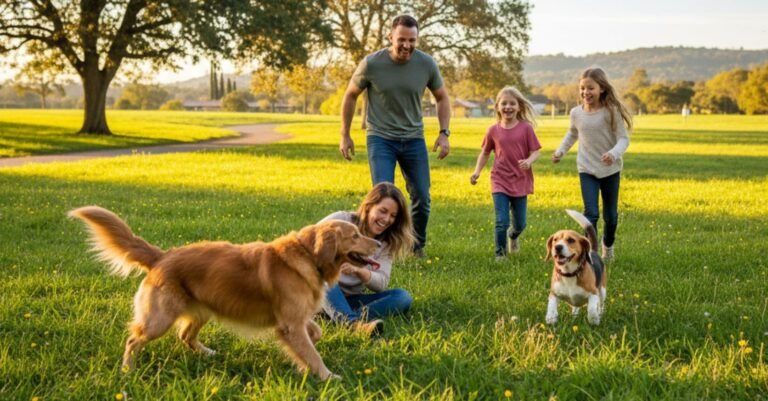
Dog Training for Beginners: A Complete Guide to Raising a Well-Behaved Pet
Dogs aren’t just pets—they become family. But just like children, they need guidance, structure, and training to thrive in a home. If you’re new to owning a dog, training might seem overwhelming at first. Don’t worry. Whether you have a bouncy puppy or an older rescue, this beginner-friendly dog training guide will help you understand, bond with, and properly train your dog from day one.
Table of Contents
ToggleWhy Training Matters (Especially for Beginners)
Training a dog isn’t just about teaching tricks—it’s about creating a language between you and your pet. A well-trained dog is:
- Easier to manage
- More confident
- Less stressed
- Safer around family and other animals
Dog training for beginners is more than obedience—it’s about trust, communication, and respect.
Unlock Your Dog's Hidden Intelligence with Brain Training for Dogs
Understanding Dog Behavior Basics
Before you start teaching commands, it’s important to understand how dogs think. Dogs aren’t born knowing human rules. Their world revolves around instincts, body language, and energy.
Key Behavior Concepts:
- Dogs learn by association. If sitting leads to a treat, they’ll repeat it.
- Timing is crucial. A reward must come immediately after the behavior.
- Consistency builds understanding. Mixed messages confuse dogs.
Once you grasp these basics, the rest of dog training becomes much easier.
Setting the Stage: What You Need Before Training
- A Calm Environment: Start in a distraction-free space.
- Training Treats: Small, tasty rewards work best.
- Leash and Collar or Harness: Control and safety matter.
- Patience and Time: Results come from repetition, not pressure.
Creating a routine helps both you and your dog stay on track.
Unlock Your Dog's Hidden Intelligence with Brain Training for Dogs
Puppy Training Tips: Start Right from Day One
If you’ve just brought home a puppy, congratulations! This stage is full of energy and curiosity. Puppies absorb information quickly, but they also get bored fast. Here’s how to start strong:
- Socialization
- Expose your puppy to various sounds, people, textures, and places early on. This reduces fear and anxiety later.
- Potty Training
- Take them out every 2 hours and after eating or playing.
- Use a cue word like “go potty.”
- Reward immediately when they do it outside.
- Crate Training
- Use the crate as a safe space, not punishment.
- Keep training sessions short and positive.
Pro Tip: Avoid harsh corrections. At this age, shaping good behavior is more effective than punishing bad ones.
How to Train Your Dog at Home (Simple Daily Routine)
You don’t need a fancy setup or a professional trainer to get results. You can train your dog right at home by investing just 10–15 minutes per day. Here’s a basic training plan for beginners:
Morning Routine
- Short leash walk with “heel” practice
- Practice “sit” and “stay” before meals
- Mental enrichment (sniff games or puzzle toys)
Afternoon Play
- Short fetch or tug session
- Reinforce commands like “come” and “leave it”
Evening Calm
- Practice “down” or “place” commands to settle
- Crate or calm place rest
Repetition in natural settings cements training faster than random drills.
Unlock Your Dog's Hidden Intelligence with Brain Training for Dogs
Core Commands: Basic Obedience Training Every Dog Should Know
Even the most playful or stubborn pup can learn the five essential commands. These form the foundation of obedience and daily safety.
- Sit
- Hold a treat above the dog’s head
- Say “sit” as you move the treat back
- When their bottom touches the floor, reward
- Stay
- Ask your dog to sit
- Show a flat palm, say “stay”
- Step back one pace, then reward if they stay
- Come (Recall)
- Say your dog’s name with “come” in an excited tone
- Reward generously when they return
- Never use “come” to punish
- Down
- From a sit, lower a treat to the ground
- Slowly drag it out so they lie down to follow
- Say “down,” then treat
- Leave It
- Place a low-value item on the ground
- Cover it with your hand if they go for it
- Say “leave it” and wait
- Reward with a better treat when they back off
Practicing these consistently makes daily life much easier and safer.

Positive Reinforcement Dog Training: The Heart of Every Method
Forget outdated dominance theories. Science now backs positive reinforcement dog training as the most effective, humane, and lasting approach. Here’s why:
- Builds trust
- Reduces anxiety
- Boosts learning speed
- Deepens the bond between you and your dog
Examples of Positive Reinforcement:
- Treats
- Praise (“Good boy/girl!”)
- Play or toys
- Belly rubs
Remember: Reward the behavior you want, and ignore the behavior you don’t (unless safety is at risk).
Common Beginner Mistakes (And How to Avoid Them)
Training a dog isn’t always a straight path. Here are rookie errors you’ll want to dodge:
| Mistake | Why It’s a Problem | Fix |
|---|---|---|
| Inconsistency | Confuses the dog | Set clear rules and routines |
| Overcorrection | Breaks trust | Redirect or ignore minor bad behavior |
| Skipping rewards | Reduces motivation | Keep a reward system |
| Repeating commands | Weakens command strength | Say it once, then guide the behavior |
| Training too long | Causes frustration | Keep sessions short and fun |
Mistakes are part of learning—for both of you.
How Long Does It Take to Train a Dog?
There’s no fixed timeline. A puppy might take weeks, while an older dog may need months to unlearn bad habits. The keys are:
- Daily practice
- Positive reinforcement
- Realistic expectations
Celebrate small wins like sitting on command or coming when called. Over time, these build into lasting behavior.
What If My Dog Is Older or Adopted?
It’s never too late to train a dog. Senior dogs can learn new tricks, though they may take more time due to previous habits. With patience and understanding, how to train your dog at home becomes a meaningful process of re-building trust and structure.
Extra Tips for Older Dogs:
- Keep sessions shorter
- Avoid loud tones or fast hand movements
- Be extra generous with rewards
Tools That Can Help You Train at Home
You don’t need much, but a few items can make home training smoother:
- Clicker (for clicker training)
- Long leash for recall
- Treat pouch
- Interactive toys
- Training mats
Avoid tools like shock collars or choke chains—they can damage both trust and your dog’s health.
When to Seek Professional Help
Some dogs may show signs of anxiety, reactivity, or past trauma. In those cases, consider:
- Certified dog trainers
- Online dog training programs
- Veterinary behaviorists
Look for trainers who use positive reinforcement and are CPDT-KA or IAABC certified.
Conclusion: Start Today and Grow Together
Training your dog might seem like a long road, but every command mastered, every behavior improved, and every moment of bonding makes it worth the effort. As a beginner, your secret weapon is consistency and love. Over time, your pet will grow into a well-behaved, happy companion—and you’ll grow into a confident dog parent.
So grab those treats, leash up, and start training today. A well-trained dog isn’t just easier to live with—it’s a joy to be around.
Frequently Asked Questions (FAQs)
What is the best way to start dog training for beginners?
Start with basic commands like ‘sit’, ‘stay’, and ‘come’ using positive reinforcement. Keep sessions short and consistent.
Can I train my dog at home without a professional?
Yes, most basic training can be done at home using treats, patience, and consistency. Professional help is only needed for behavioral issues.
How long does it take to train a dog?
Training duration depends on the dog’s age, breed, and personality. With daily practice, most dogs learn basic commands in a few weeks.
Is positive reinforcement dog training effective?
Yes. It builds trust, strengthens behavior patterns, and is proven to be more effective and humane than punishment-based methods.
At what age should I start training my puppy?
You can start basic training and socialization as early as 8 weeks old. Puppies learn quickly and benefit from early guidance.
What are the most important basic obedience commands?
The top five commands for beginners are: sit, stay, come, down, and leave it. These build a strong foundation for behavior.
Can adult dogs still be trained?
Absolutely. Adult and even senior dogs can learn new behaviors with the right motivation, patience, and consistent training.
Do I need special tools to train my dog?
You don’t need much—treats, a leash, a collar, and possibly a clicker. Avoid harsh tools like shock or choke collars.
How often should I train my dog?
Train your dog for 10–15 minutes per day, in multiple short sessions. Regularity helps dogs learn faster and retain commands better.
What if my dog doesn’t respond to training?
Try adjusting your approach—use higher-value rewards, check for distractions, or seek help from a certified positive-reinforcement trainer.
Recent Posts









Related Topics
Copyright © 2025 The Pet Blog – Expert Tips, Care Guides & Fun Facts for Every Pet Lover.


